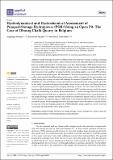Por favor, use este identificador para citar o enlazar a este item:
http://hdl.handle.net/10261/245071COMPARTIR / EXPORTAR:
 SHARE SHARE
 CORE
BASE CORE
BASE
|
|
| Visualizar otros formatos: MARC | Dublin Core | RDF | ORE | MODS | METS | DIDL | DATACITE | |

| Título: | Hydrodynamical and Hydrochemical Assessment of Pumped-Storage Hydropower (PSH) Using an Open Pit: The Case of Obourg Chalk Quarry in Belgium |
Autor: | Poulain, Angélique; Pujades, Estanislao CSIC ORCID; Goderniaux, Pascal | Palabras clave: | Pumped storage hydropower Energy storage systems Hydropower Quarry Open pit Numerical modelling Hydrochemistry Environmental impacts |
Fecha de publicación: | 27-may-2021 | Editor: | Multidisciplinary Digital Publishing Institute | Citación: | Applied Sciences 11 (11): 4913 (2021) | Resumen: | Pumped storage hydropower (PSH) enables the temporary storage of energy, including from intermittent renewable sources, and provides answers to the difficulties related to the mismatch between supply and demand of electrical energy over time. Implementing a PSH station requires two reservoirs at different elevations and with large volumes of water. The idea of using old, flooded open-pit quarries as a lower reservoir has recently emerged. However, quarries cannot be considered as impervious reservoirs, and they are connected to the surrounding aquifers. As a result, PSH activities may entail environmental impacts. The alternation of the pumping–discharge cycles generates rapid and periodic hydraulic head fluctuations in the quarry, which propagate into the surrounding rock media forcing the exchange of water and inducing the aeration of groundwater. This aeration can destabilize the chemical balances between groundwater and minerals in the underground rock media. In this study, two numerical groundwater models based on the chalk quarry of Obourg (Belgium) were developed considering realistic pumping–discharge scenarios. The aim of these models was to investigate the hydrodynamic and hydrochemical impact of PSH activities on water inside the quarry and in the surrounding rock media. Results showed that (1) water exchanges between the quarry and the adjacent rock media have a significant influence on the hydraulic head, (2) the frequency of the pump–discharge scenarios influence the potential environmental impacts, and (3), in the case of chalk formations, the expected impact of PSH on the water chemical composition is relatively limited around the quarry. Results highlight that those hydrogeological and hydrochemical concerns should be assessed when developing a project of a PSH installation using a quarry as a lower reservoir, considering all particularities of the proposed sites. | Versión del editor: | https://doi.org/10.3390/app11114913 | URI: | http://hdl.handle.net/10261/245071 | DOI: | 10.3390/app11114913 |
| Aparece en las colecciones: | (IDAEA) Artículos |
Ficheros en este ítem:
| Fichero | Descripción | Tamaño | Formato | |
|---|---|---|---|---|
| applsci-11-04913.pdf | Artículo principal | 4,71 MB | Adobe PDF |  Visualizar/Abrir |
CORE Recommender
SCOPUSTM
Citations
5
checked on 04-may-2024
WEB OF SCIENCETM
Citations
1
checked on 24-feb-2024
Page view(s)
74
checked on 07-may-2024
Download(s)
89
checked on 07-may-2024
Google ScholarTM
Check
Altmetric
Altmetric
NOTA: Los ítems de Digital.CSIC están protegidos por copyright, con todos los derechos reservados, a menos que se indique lo contrario.
